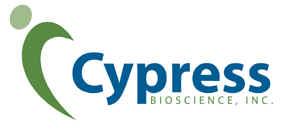|
|
Cypress Bioscience, Inc. (CYPB) |
|
|
CEOCFO Current
Issue |
This is a printer friendly page! Cypress Bioscience has recently
completed their Phase II clinical trials for Milnacipran used for the treatment of
Fibromyalgia Syndrome and expects to initiate the Phase III studies by the end of the year BIO: FMS, a chronic pain syndrome, has been the focus of
Cypress Bioscience’s initial efforts in the area of FSS. FMS affects between 2-4% of
the world's population. FMS is a chronic and severely debilitating condition characterized
by widespread pain and stiffness throughout the body accompanied by severe fatigue, poor
sleep and headache. There is also a high incidence of associated neurologic, allergic,
cardiac, pulmonary, gastrointestinal, genitourinary, and affective symptoms among
sufferers. Patients with FMS have at least comparable disability, more pain and lower
quality of life than patients with rheumatoid arthritis or osteoarthritis. Cypress' Science & Technology program is
comprised of a number of research initiatives, including the preclinical development
program for milnacipran and other agents as well as studies into the pathophysiology and
genetics underlying fibromyalgia syndrome (FMS). It is hoped that with further research
the level of understanding of FMS will continue to increase, so that optimum diagnostic
tools and treatments can be developed. CEOCFOinterviews: Ms.
Martucci Johnson, tell us about Cypress Bioscience and the work that you do? Ms. Martucci Johnson: “About two years ago, we began an initiative in the area of Fibromyalgia Syndrome (FMS), which is a chronic pain condition and that became the focus of our company. Prior to that, we were involved in rheumatoid arthritis and had a product that we were directly selling and marketing. After divesting that product, we became very interested in the area of fibromyalgia and began focusing on that. Shortly after we decided to proceed in this direction, we licensed a product called Milnacipran which is currently in clinical development for treatment of fibromyalgia. We just completed a successful Phase II trial, evaluating that compound as a treatment for Fibromyalgia Syndrome.” CEOCFOinterviews: Why the decision to find a treatment for fibromyalgia? Ms. Martucci Johnson: “We had been involved with a product for rheumatoid arthritis and we were attending a number of rheumatology conferences. At these conferences, our CEO, Jay D. Kranzler, who is an M.D. and Ph.D, with a background in psychiatry, noticed some sessions on fibromyalgia. He became interested because of such an interesting overlap of mind and body symptoms in this condition. The hallmark symptom of fibromyalgia is widespread chronic pain. There are also components of other less tangible symptoms such as fatigue, mood disorders and difficulty sleeping. The more we learned about it, the more it became interesting to all of us as we realized that it was a very common condition affecting about two to four percent of the population. If you compare that to other conditions, it is larger than rheumatoid arthritis and is second only to osteoarthritis in the rheumatology clinic. So, based on the market size, it was certainly interesting to us. We also learned that there were no treatments available for this condition; there were no drugs specifically developed or approved by the FDA for the treatment of fibromyalgia. Out of our own research, we became confident that the condition was treatable and that there were probably compounds out there that might be successful in managing this condition and that it could be demonstrated in a clinical trial.” CEOCFOinterviews: What is next after Phase II? Ms. Martucci Johnson: “We looked at pain in the study and 37% of the patients treated with our drug Milnacipran, reported a 50% reduction in their level of pain and that is compared to just 14% in the placebo group. We asked about the overall improvement and 75% of the Milnacipran treated patients reported that they were improved overall compared to when they started the study and that is compared to 38% in the placebo group. Our next steps are to finalize our Phase III program. Those are the studies that we are going to need to do in order to submit to the FDA and get approval to market the drug. We are in the process of finalizing what those studies are going to entail and anticipate actually initiating those studies before the end of the year.” CEOCFOinterviews: How do you fund all this? Ms. Martucci Johnson: “We are fortunate that last year we completed a 17 million dollar private placement and last month we completed a private placement of just over ten million. We have twenty million dollars in the bank right now, which is adequate to get us well into our Phase III programs and get us on the road to getting ready to file for approval with the FDA.” CEOCFOinterviews: How far down the line will that be? Ms. Martucci Johnson: “The Phase III program of itself, will take some time. After the data is in order you then file with the FDA, so a conservative estimate would be by the end of 2006.” CEOCFOinterviews: Is there a marketing strategy yet? Ms. Martucci Johnson: “We have realized that fibromyalgia is a primary care condition and most patients go to their primary care physicians to get their treatments. We expect that will be even more common once they have approved treatment for fibromyalgia. We recognized early on that we were going to require a marketing partner to help us commercialize this product. We intend to partner with a pharmaceutical company, someone with a large primary care sales organization, before the product is approved. The timing of that partnership is a strategic decision.” CEOCFOinterviews: You mentioned the problem of fibromyalgia was not being addressed. Is there any other research and competition for Cypress? Ms. Martucci Johnson: “If you would have asked me that in January of 2001, I would have said no. But things have changed and other companies are realizing that there is a population of patients that need new treatments – an unmet need. Pfizer Inc. (NYSE: PFE) has done some clinical research in this area with one of their compounds and they have completed a Phase II trial, which they announced at the end of last year.” CEOCFOinterviews: Please tell me about the superiority of electronic diaries as a method of recording pain assessments which was used in your Phase II program. Ms. Martucci Johnson: “When we began our Phase II program we realized that we had an opportunity to help set the standard to how Phase II and Phase III trials in this area should be conducted because there were not any large multi-centered trials at the time that we initiated our Phase II program. We took a close look at how pain studies had been conducted and what kinds of things we could do to help make the measurement and recording of pain a little quantitative. We felt that if we could capture pain measurements on a more frequent basis, we would help eliminate what is called “recall bias.” If you ask someone once a month how their pain is, they are trying to remember what it was like over that last month and they are likely to be biased by their most current experience. We recommended using an electronic diary system, which prompts you throughout the day to answer questions about your pain. We recognize that by using a system like this we also eliminate the possibility for someone to back-enter the data. What often happens with a paper-and-pencil diary, and there have been studies to demonstrate this, is that people throw out a weeks worth of information in the thirty minutes that they are waiting to see their physician at the end of that week. We incorporated this electronic diary into our Phase II trial as a way to measure pain more frequently and randomly.” CEOCFOinterviews: Other than helping to validate your study, do you benefit in other ways? Ms. Martucci Johnson: “Trying to do something that was cutting-edge has helped move the technology forward. For example, we were asked to speak at an NIH FDA meeting about measuring pain in clinical trials and that was an honor for us to be able to present our approach of measuring pain in such a forum. Throughout the academic community, and with our peers in industry as well, you do get praise for taking a cutting-edge approach. It is clear that we are taking a step to help strengthen the way the data is collected and further that aspect of clinical trials.” CEOCFOinterviews: Please explain Cypress’ commitment to be an innovator in diagnosis and treatment of patients with Functional Somatic Syndromes. Ms. Martucci Johnson: “Functional Somatic Syndrome (FSS) is a term that we use to describe a number of different conditions, wherein the similarity among them are the types of symptoms that the patient experiences. If the physician did a physical exam trying to look at biological changes that would justify the symptoms, they would have difficulty finding such things. For instance with fibromyalgia, the hallmark symptom is pain. It feels like muscle pain or that there might be something wrong with the joints, but if the physician did an exam, he would not find any joint damage or any damage to the muscles. This is true amongst all of the Functional Somatic Symptoms. Another example would be tension and migraine headaches, some types of lower back pain and irritable bowel syndrome. Those are all examples where the symptoms that the patient feels are all very real, but a physical exam does not demonstrate defects or disease process to account for those symptoms. In the case of fibromyalgia, there have been studies using magnetic residence imaging of the brain demonstrating that when these people say that they are experiencing pain. If you look at what is happening in their brain, they really are. It is just that you cannot find a physical source for that pain. Many of the Functional Somatic Symdromes are conditions where a drug such as Milnacipran, which we are evaluating, and which acts on two very important neurotransmitters in your brain, namely Serotonin and Norepinephrine, are conditions where, theoretically, a drug with this type of pharmacology could potentially be effective. In the future, we definitely hope to initiate pilot studies looking at some of these other conditions as well.” CEOCFOinterviews: What should potential investors know that perhaps they don’t realize when they look on the surface of Cypress Bioscience. Ms. Martucci Johnson: “The message that we always hope investors will take away is that fibromyalgia is a real medical condition and that there are criteria for its diagnosis. It is a condition that is treatable and the compound that we have selected has a pharmacological profile that is very similar to some of the drugs that are currently being used. These very old drugs are called tricyclic antidepressants (TCAs) that have the same sort of preference for Norepinephrine with some Serotonin activity as milnacipran does. But these TCA drugs are riddled with side-effect problems because of all the other activity that they have. We selected a compound that is similar pharmacologically to the positive aspects of these drugs that have been already demonstrated to work in fibromyalgia and in some of the other functional somatic syndromes, but lack side-effect profile. The promise of the compound goes beyond fibromyalgia. I think sometimes people looking at the company and the compound do not quite realize the full potential and opportunity that the compound holds.” disclaimers |
|
To view Releases highlight & left click on the company name!
|
|





